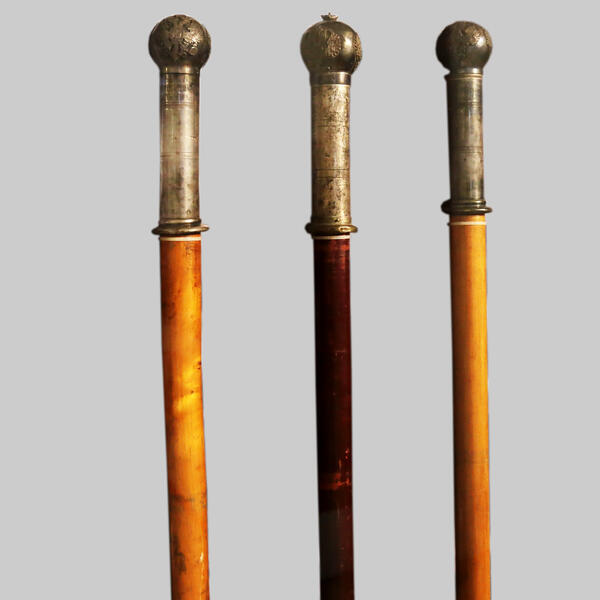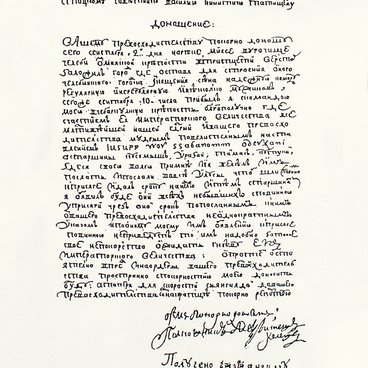A naseka was a staff with a metal pommel, which had the names of the Atamans (a title of Cossack leaders of various kinds) who once owned it “inscribed” on it. The atamans of different stanItsas (villages inside a Cossack host) and settlements each had their own naseka. It was a long, thick cane about shoulder-length and with a round pommel. The naseka was passed on to the next elected ataman and was kept in the administrations of stanItsas, districts, and Cossack host divisions together with other relics.
The Brockhaus and Efron Encyclopedic Dictionary (1897 edition) defines naseka as a “special symbol of merit in the Cossack troops, assigned by the May 10, 1885 order of the Committee of Ministers to the stanItsa and settlement Atamans and consolidated by the Imperial Court.”
The naseka displayed in the 20th Century History Hall of the State Museum of the South Ural History is made of polished and varnished wood and is decorated with a metal pommel. Its lower part looks like a rounded cone with an ornament. The round pommel features three embossed overlays with the images of the coats of arms of the Russian Empire. All metal parts are silver plated. Three engraved lines encircle the pommel: “Ataman of the Kalachevsky settlement / Etkul stanitsa of the third military division / the Orenburg Cossack host.”
The Orenburg Cossack army was founded in 1748 by the decree of Empress Elizabeth Petrovna. The Cossacks patrolled the border and took part in wars and campaigns. The 1876 order set the length of service of the Orenburg Cossacks at 20 years. The Cossacks purchased everything they needed for military service, including a horse, a uniform, gear, and weapons, except for firearms, at their own expense. They received land plots as payment for their military service: 30 dessiatins (an archaic land measurement unit) per capita.
The Orenburg Cossacks were the most multinational army in the country. Apart from Russians and Ukrainians, it also included Tatars, Nağaybäks, Mordovians, Bashkirs, and Kalmyks. The Cossack host’s territory consisted of three military divisions, with their centers in Orenburg, Verkhneuralsk, and Troitsk.
The Kalachevsky settlement was founded by the Cossacks in the middle of the 18th century. It was part of the Etkul stanitsa yurt (a unit within the stanitsa) of the third (Troitsky) military division of the Orenburg Cossack host. This territory is now occupied by the village of Kalachevo, located on the banks of the Chumlyak River not far from Chelyabinsk.
The Brockhaus and Efron Encyclopedic Dictionary (1897 edition) defines naseka as a “special symbol of merit in the Cossack troops, assigned by the May 10, 1885 order of the Committee of Ministers to the stanItsa and settlement Atamans and consolidated by the Imperial Court.”
The naseka displayed in the 20th Century History Hall of the State Museum of the South Ural History is made of polished and varnished wood and is decorated with a metal pommel. Its lower part looks like a rounded cone with an ornament. The round pommel features three embossed overlays with the images of the coats of arms of the Russian Empire. All metal parts are silver plated. Three engraved lines encircle the pommel: “Ataman of the Kalachevsky settlement / Etkul stanitsa of the third military division / the Orenburg Cossack host.”
The Orenburg Cossack army was founded in 1748 by the decree of Empress Elizabeth Petrovna. The Cossacks patrolled the border and took part in wars and campaigns. The 1876 order set the length of service of the Orenburg Cossacks at 20 years. The Cossacks purchased everything they needed for military service, including a horse, a uniform, gear, and weapons, except for firearms, at their own expense. They received land plots as payment for their military service: 30 dessiatins (an archaic land measurement unit) per capita.
The Orenburg Cossacks were the most multinational army in the country. Apart from Russians and Ukrainians, it also included Tatars, Nağaybäks, Mordovians, Bashkirs, and Kalmyks. The Cossack host’s territory consisted of three military divisions, with their centers in Orenburg, Verkhneuralsk, and Troitsk.
The Kalachevsky settlement was founded by the Cossacks in the middle of the 18th century. It was part of the Etkul stanitsa yurt (a unit within the stanitsa) of the third (Troitsky) military division of the Orenburg Cossack host. This territory is now occupied by the village of Kalachevo, located on the banks of the Chumlyak River not far from Chelyabinsk.



